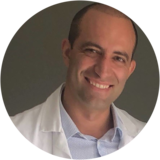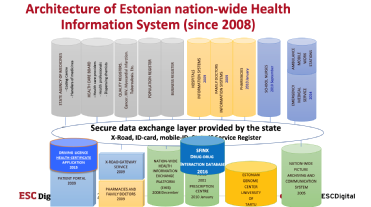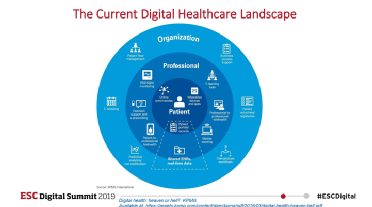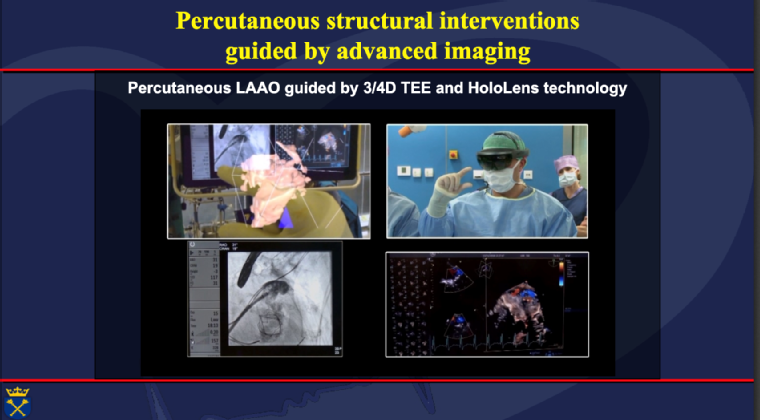 Prof. Alexandru Mischie, Secretary of the Acute Cardiovascular Care Association (ACCA) feedback on the ESC Digital Summit 2019 held in Tallin ( 5-6 October 2019).
Prof. Alexandru Mischie, Secretary of the Acute Cardiovascular Care Association (ACCA) feedback on the ESC Digital Summit 2019 held in Tallin ( 5-6 October 2019).
The ESC Digital Summit was a bold initiative by the European Society of Cardiology, and took place in Tallin.
The location was not chosen by hazard, as Estonia has 99% of health data digitised and 99% of prescriptions are digital.
Prof. Viigimaa exposed the architecture of the Estonian Electronic health system in a comprehensive presentation at the beginning of the congress.
Current organisation of digital healthcare
Reviewed by Prof. Martin Cowie in an excellent presentation "The digital doctor", where he highlighted that we need to identify barriers and find appropriate solutions on this emerging sector.
We will always find at the center of our care the patient and his family, and this aspect should not be overlooked or forgotten, especially in this rapid-digitalized era.


Patient care, patient empowerment and nursing issues
These topics were also addressed by Donna Fitzimmons and ACNAP President Elect , Lis Neubeck, with an accent on developing the short and longer path to action which have in center the patient and the nurse (as a midlevel team member).
Digital nursing sessions drew a lot of constructive comments, with Donna Fitzimmons opinioned that if the patient is art ease at using online interaction with a “digital” nurse (avatar talking and guiding the patient by means of AI), then we should use this technology mainly to prevent, and not to treat. Find the interesting slides from their full presentations "The digital nurse".
Preparing the healthcare force for the digital future
A very interesting session addressed the issue chaired by the Acute Cardiovascular Care Associations' President Susanna Price.
Even though some solutions have been highlighted in an important scientific paper, like as the need for a culture of learning (develop extensive learning environment, encourage innovation and dare to fail), building a strong learning infrastructure and developing a multi-professional and collaborative approach to learning, these approaches are unachievably in the current state of the medical system in Europe, where most of the current medical personnel are disengaged or over-fatigued, doctors and nurses are burned-out.
Does technology make things worse for medical workers? Can artificial intelligence and automation ease things? See all the debate of the roundtable "Set the scene preparing the healthcare workforce for the digital future here "
While trying to find solutions for the future, present issues of healthcare professionals and the digital boom relate to lack of trust and poor experience with new technologies, difficulty to interact with technology, fear of change.
Electronic medical record (EMR)
A special session to EMR can be accessed here.
The consensus was that even though EMRs are an efficient data base that can help health professionals in decision making, it is also time-consuming.
A new concept that consists on “less keyboard, more patient contact” should be adopted, because according to one study " Allocation of Physician Time in Ambulatory Practice: A Time and Motion Study in 4 Specialties.", for every hour physicians provide direct clinical face time to patients, nearly two additional hours are spent on EMR and desk work within the clinic day, and outside office hours, physicians spend another one to two hours of personal time each night doing additional computer and other clerical work.
Dr. Nico Bruining highlighted an important limitation of EMR used in Europe (vs. US), where we use more than 30 languages that make data collection difficult, and that should probably be aimed by a future Horizon 2020 project.
Cybersecurity
It was a hot topic. Dr. Avi Fischer resumed some of the important cautions to take in reducing cybersecurity risks, such as:
- sharing responsibility between stakeholders-healthcare facilities, patients, providers, and manufacturers of medical device;
- cybersecurity should be a priority during the design and development phase of the medical device and the issue should be addressed in a “Bolt-On to Integrated” fashion;
- if a vulnerability is found, communication and coordinated actions between stakeholders and healthcare facilities are vital. Development and involvement of government structures to assure security are very important.
The participants also expressed the urgent need for developing secured protocols to transmit data.
Augmented, mixed and virtual reality
The debates were really interesting. The 3 terms are intercorrelated and should not be confused with another:
- Virtual reality (VR) immerses users in a fully artificial digital environment.
- Augmented reality (AR) overlays virtual objects on the real-world environment.
- Mixed reality (MR) not just overlays but anchors virtual objects to the real world. debates were really interesting.

The two main applications in medicine target the patients and of course the doctors.
My perspective of augmented, mixed and virtual reality in medicine
- For patients, Dr Juhi Tandon, suggested that VR will do for patient education what Google Maps has done for navigation, thus it “will transform learning experiences by better retention and recall, it will improve the patient journey and will determine behavioural change by challenging health beliefs through impactful experiences”.
- For doctors, Dr. Dariusz Dudek explained how a pioneer programme of mixed reality that is currently used in Poland helps cardiologists choose a better punction site for TAVI, with expectancy in the very near future to have VR mask that will allow cardiologists to have echo, CT and eventually other 3D reconstructions in the corner of their eyes, while a cardiac intervention is taking place. Other important applications are stroke recovery and cardiac rehabilitation.
Over-utilisation of medical devices
One of the worries highlighted was that this new technology could cause anxiety in healthy fit subjects, translating into unnecessary consultations either by their general practitioner either by their cardiologist, as presented by Prof. Martin Cowie, 57% of subjects from the “Apple heart” study thought to seek medical attention after having an alarm from a smart device.
Even though wearables and connected devices impact sometimes positively our daily lives (sleep apnea analysis app, selfie to quantify oedema app, accelerometers incorporated into devices that quantify daily effort, smartphone-based blood pressure measurement by transdermal optimal imaging, etc), Dr. Klaus Witte highlighted that there is increased concern that wearables and connected devices impact negatively the society by increased (but unnecessary) cost to the consumer, and increases (but unnecessary) cost to the medical system (by over-investigating a healthy person thus launching a battery of tests like Holter ECG, echocardiography, stress test).
With this in mind, there was a unanimous consensus that medical wearables and connected devices should target special groups of populations if we want to avoid death, strokes or hospitalizations and the clinical benefit of these kinds of devices should be carefully thought and evaluated.
Conclusion
Digital technology can help healthcare by providing new tools for diagnosis and therapy delivery, redesigning clinical pathways, individualized risk stratification and individualised care, patient empowerment and education, support to precision medicine (thus fewer medical errors), and telemonitoring. Digital technology and connected devices (tablets, wearables, apps) could enhance decision making of health professionals only if there is a direct link towards a clinical benefit, and maybe they would have a huge impact if they could be directly linked also to EMR. In real life, adoption of digital technology in healthcare depends on validation, easy integration of workflow & prescription pathways and ability to reduce work.
Consumers could think that by using digital technology and connected devices, they take control over their health; this is partially false because alarms issued by devices could translate into unnecessary consultations and increased the cost to the overall health system by doing unnecessary tests in otherwise healthy subjects. Narrowing the indications and the target population for the use of these devices should be a priority.
And finally, some punctual issues need rapid and clear solutions: stricter security protocols should be incorporated in data transmission, regulations should be adopted for all digital technology (there are too many devices and few regulations), the huge amount of data (that is collected from all digital technology) needs to be transformed into information.

 Our mission: To reduce the burden of cardiovascular disease.
Our mission: To reduce the burden of cardiovascular disease.